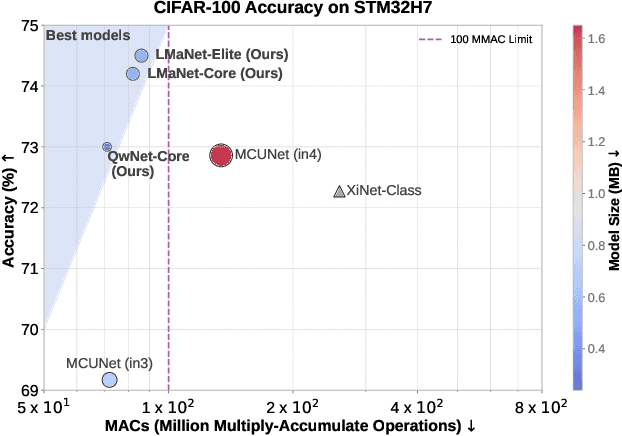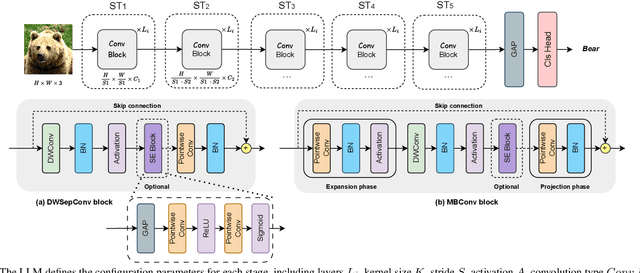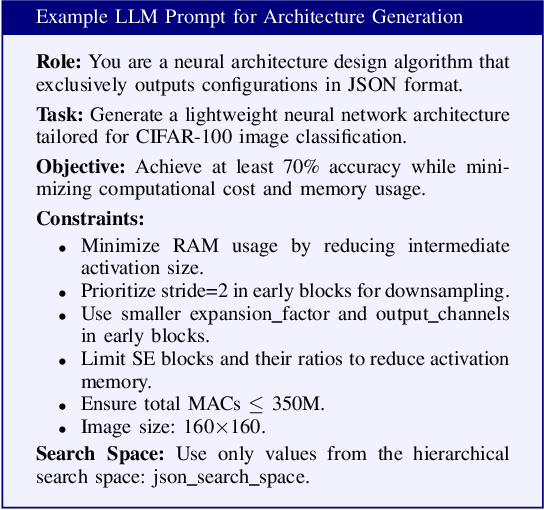Wassim Hamidouche
Univ. Rennes, INSA Rennes, CNRS, IETR - UMR 6164, Rennes, France
Designing Object Detection Models for TinyML: Foundations, Comparative Analysis, Challenges, and Emerging Solutions
Aug 11, 2025Abstract:Object detection (OD) has become vital for numerous computer vision applications, but deploying it on resource-constrained IoT devices presents a significant challenge. These devices, often powered by energy-efficient microcontrollers, struggle to handle the computational load of deep learning-based OD models. This issue is compounded by the rapid proliferation of IoT devices, predicted to surpass 150 billion by 2030. TinyML offers a compelling solution by enabling OD on ultra-low-power devices, paving the way for efficient and real-time processing at the edge. Although numerous survey papers have been published on this topic, they often overlook the optimization challenges associated with deploying OD models in TinyML environments. To address this gap, this survey paper provides a detailed analysis of key optimization techniques for deploying OD models on resource-constrained devices. These techniques include quantization, pruning, knowledge distillation, and neural architecture search. Furthermore, we explore both theoretical approaches and practical implementations, bridging the gap between academic research and real-world edge artificial intelligence deployment. Finally, we compare the key performance indicators (KPIs) of existing OD implementations on microcontroller devices, highlighting the achieved maturity level of these solutions in terms of both prediction accuracy and efficiency. We also provide a public repository to continually track developments in this fast-evolving field: https://github.com/christophezei/Optimizing-Object-Detection-Models-for-TinyML-A-Comprehensive-Survey.
RAVID: Retrieval-Augmented Visual Detection: A Knowledge-Driven Approach for AI-Generated Image Identification
Aug 05, 2025Abstract:In this paper, we introduce RAVID, the first framework for AI-generated image detection that leverages visual retrieval-augmented generation (RAG). While RAG methods have shown promise in mitigating factual inaccuracies in foundation models, they have primarily focused on text, leaving visual knowledge underexplored. Meanwhile, existing detection methods, which struggle with generalization and robustness, often rely on low-level artifacts and model-specific features, limiting their adaptability. To address this, RAVID dynamically retrieves relevant images to enhance detection. Our approach utilizes a fine-tuned CLIP image encoder, RAVID CLIP, enhanced with category-related prompts to improve representation learning. We further integrate a vision-language model (VLM) to fuse retrieved images with the query, enriching the input and improving accuracy. Given a query image, RAVID generates an embedding using RAVID CLIP, retrieves the most relevant images from a database, and combines these with the query image to form an enriched input for a VLM (e.g., Qwen-VL or Openflamingo). Experiments on the UniversalFakeDetect benchmark, which covers 19 generative models, show that RAVID achieves state-of-the-art performance with an average accuracy of 93.85%. RAVID also outperforms traditional methods in terms of robustness, maintaining high accuracy even under image degradations such as Gaussian blur and JPEG compression. Specifically, RAVID achieves an average accuracy of 80.27% under degradation conditions, compared to 63.44% for the state-of-the-art model C2P-CLIP, demonstrating consistent improvements in both Gaussian blur and JPEG compression scenarios. The code will be publicly available upon acceptance.
DeeCLIP: A Robust and Generalizable Transformer-Based Framework for Detecting AI-Generated Images
Apr 28, 2025Abstract:This paper introduces DeeCLIP, a novel framework for detecting AI-generated images using CLIP-ViT and fusion learning. Despite significant advancements in generative models capable of creating highly photorealistic images, existing detection methods often struggle to generalize across different models and are highly sensitive to minor perturbations. To address these challenges, DeeCLIP incorporates DeeFuser, a fusion module that combines high-level and low-level features, improving robustness against degradations such as compression and blurring. Additionally, we apply triplet loss to refine the embedding space, enhancing the model's ability to distinguish between real and synthetic content. To further enable lightweight adaptation while preserving pre-trained knowledge, we adopt parameter-efficient fine-tuning using low-rank adaptation (LoRA) within the CLIP-ViT backbone. This approach supports effective zero-shot learning without sacrificing generalization. Trained exclusively on 4-class ProGAN data, DeeCLIP achieves an average accuracy of 89.00% on 19 test subsets composed of generative adversarial network (GAN) and diffusion models. Despite having fewer trainable parameters, DeeCLIP outperforms existing methods, demonstrating superior robustness against various generative models and real-world distortions. The code is publicly available at https://github.com/Mamadou-Keita/DeeCLIP for research purposes.
Can LLMs Revolutionize the Design of Explainable and Efficient TinyML Models?
Apr 13, 2025



Abstract:This paper introduces a novel framework for designing efficient neural network architectures specifically tailored to tiny machine learning (TinyML) platforms. By leveraging large language models (LLMs) for neural architecture search (NAS), a vision transformer (ViT)-based knowledge distillation (KD) strategy, and an explainability module, the approach strikes an optimal balance between accuracy, computational efficiency, and memory usage. The LLM-guided search explores a hierarchical search space, refining candidate architectures through Pareto optimization based on accuracy, multiply-accumulate operations (MACs), and memory metrics. The best-performing architectures are further fine-tuned using logits-based KD with a pre-trained ViT-B/16 model, which enhances generalization without increasing model size. Evaluated on the CIFAR-100 dataset and deployed on an STM32H7 microcontroller (MCU), the three proposed models, LMaNet-Elite, LMaNet-Core, and QwNet-Core, achieve accuracy scores of 74.50%, 74.20% and 73.00%, respectively. All three models surpass current state-of-the-art (SOTA) models, such as MCUNet-in3/in4 (69.62% / 72.86%) and XiNet (72.27%), while maintaining a low computational cost of less than 100 million MACs and adhering to the stringent 320 KB static random-access memory (SRAM) constraint. These results demonstrate the efficiency and performance of the proposed framework for TinyML platforms, underscoring the potential of combining LLM-driven search, Pareto optimization, KD, and explainability to develop accurate, efficient, and interpretable models. This approach opens new possibilities in NAS, enabling the design of efficient architectures specifically suited for TinyML.
Advancing THz Radio Map Construction and Obstacle Sensing: An Integrated Generative Framework in ISAC
Mar 29, 2025Abstract:Integrated sensing and communication (ISAC) in the terahertz (THz) band enables obstacle detection, which in turn facilitates efficient beam management to mitigate THz signal blockage. Simultaneously, a THz radio map, which captures signal propagation characteristics through the distribution of received signal strength (RSS), is well-suited for sensing, as it inherently contains obstacle-related information and reflects the unique properties of the THz channel. This means that communication-assisted sensing in ISAC can be effectively achieved using a THz radio map. However, constructing a radio map presents significant challenges due to the sparse deployment of THz sensors and their limited ability to accurately measure the RSS distribution, which directly affects obstacle sensing. In this paper, we formulate an integrated problem for the first time, leveraging the mutual enhancement between sensed obstacles and the constructed THz radio maps. To address this challenge while improving generalization, we propose an integration framework based on a conditional generative adversarial network (CGAN), which uncovers the manifold structure of THz radio maps embedded with obstacle information. Furthermore, recognizing the shared environmental semantics across THz radio maps from different beam directions, we introduce a novel voting-based sensing scheme, where obstacles are detected by aggregating votes from THz radio maps generated by the CGAN. Simulation results demonstrate that the proposed framework outperforms non-integrated baselines in both radio map construction and obstacle sensing, achieving up to 44.3% and 90.6% reductions in mean squared error (MSE), respectively, in a real-world scenario. These results validate the effectiveness of the proposed voting-based scheme.
Large-Scale AI in Telecom: Charting the Roadmap for Innovation, Scalability, and Enhanced Digital Experiences
Mar 06, 2025Abstract:This white paper discusses the role of large-scale AI in the telecommunications industry, with a specific focus on the potential of generative AI to revolutionize network functions and user experiences, especially in the context of 6G systems. It highlights the development and deployment of Large Telecom Models (LTMs), which are tailored AI models designed to address the complex challenges faced by modern telecom networks. The paper covers a wide range of topics, from the architecture and deployment strategies of LTMs to their applications in network management, resource allocation, and optimization. It also explores the regulatory, ethical, and standardization considerations for LTMs, offering insights into their future integration into telecom infrastructure. The goal is to provide a comprehensive roadmap for the adoption of LTMs to enhance scalability, performance, and user-centric innovation in telecom networks.
Energy-Latency Attacks: A New Adversarial Threat to Deep Learning
Mar 06, 2025Abstract:The growing computational demand for deep neural networks ( DNNs) has raised concerns about their energy consumption and carbon footprint, particularly as the size and complexity of the models continue to increase. To address these challenges, energy-efficient hardware and custom accelerators have become essential. Additionally, adaptable DNN s are being developed to dynamically balance performance and efficiency. The use of these strategies became more common to enable sustainable AI deployment. However, these efficiency-focused designs may also introduce vulnerabilities, as attackers can potentially exploit them to increase latency and energy usage by triggering their worst-case-performance scenarios. This new type of attack, called energy-latency attacks, has recently gained significant research attention, focusing on the vulnerability of DNN s to this emerging attack paradigm, which can trigger denial-of-service ( DoS) attacks. This paper provides a comprehensive overview of current research on energy-latency attacks, categorizing them using the established taxonomy for traditional adversarial attacks. We explore different metrics used to measure the success of these attacks and provide an analysis and comparison of existing attack strategies. We also analyze existing defense mechanisms and highlight current challenges and potential areas for future research in this developing field. The GitHub page for this work can be accessed at https://github.com/hbrachemi/Survey_energy_attacks/
Energy Backdoor Attack to Deep Neural Networks
Jan 14, 2025



Abstract:The rise of deep learning (DL) has increased computing complexity and energy use, prompting the adoption of application specific integrated circuits (ASICs) for energy-efficient edge and mobile deployment. However, recent studies have demonstrated the vulnerability of these accelerators to energy attacks. Despite the development of various inference time energy attacks in prior research, backdoor energy attacks remain unexplored. In this paper, we design an innovative energy backdoor attack against deep neural networks (DNNs) operating on sparsity-based accelerators. Our attack is carried out in two distinct phases: backdoor injection and backdoor stealthiness. Experimental results using ResNet-18 and MobileNet-V2 models trained on CIFAR-10 and Tiny ImageNet datasets show the effectiveness of our proposed attack in increasing energy consumption on trigger samples while preserving the model's performance for clean/regular inputs. This demonstrates the vulnerability of DNNs to energy backdoor attacks. The source code of our attack is available at: https://github.com/hbrachemi/energy_backdoor.
360-Degree Video Super Resolution and Quality Enhancement Challenge: Methods and Results
Nov 11, 2024Abstract:Omnidirectional (360-degree) video is rapidly gaining popularity due to advancements in immersive technologies like virtual reality (VR) and extended reality (XR). However, real-time streaming of such videos, especially in live mobile scenarios like unmanned aerial vehicles (UAVs), is challenged by limited bandwidth and strict latency constraints. Traditional methods, such as compression and adaptive resolution, help but often compromise video quality and introduce artifacts that degrade the viewer experience. Additionally, the unique spherical geometry of 360-degree video presents challenges not encountered in traditional 2D video. To address these issues, we initiated the 360-degree Video Super Resolution and Quality Enhancement Challenge. This competition encourages participants to develop efficient machine learning solutions to enhance the quality of low-bitrate compressed 360-degree videos, with two tracks focusing on 2x and 4x super-resolution (SR). In this paper, we outline the challenge framework, detailing the two competition tracks and highlighting the SR solutions proposed by the top-performing models. We assess these models within a unified framework, considering quality enhancement, bitrate gain, and computational efficiency. This challenge aims to drive innovation in real-time 360-degree video streaming, improving the quality and accessibility of immersive visual experiences.
Bi-LORA: A Vision-Language Approach for Synthetic Image Detection
Apr 07, 2024



Abstract:Advancements in deep image synthesis techniques, such as generative adversarial networks (GANs) and diffusion models (DMs), have ushered in an era of generating highly realistic images. While this technological progress has captured significant interest, it has also raised concerns about the potential difficulty in distinguishing real images from their synthetic counterparts. This paper takes inspiration from the potent convergence capabilities between vision and language, coupled with the zero-shot nature of vision-language models (VLMs). We introduce an innovative method called Bi-LORA that leverages VLMs, combined with low-rank adaptation (LORA) tuning techniques, to enhance the precision of synthetic image detection for unseen model-generated images. The pivotal conceptual shift in our methodology revolves around reframing binary classification as an image captioning task, leveraging the distinctive capabilities of cutting-edge VLM, notably bootstrapping language image pre-training (BLIP2). Rigorous and comprehensive experiments are conducted to validate the effectiveness of our proposed approach, particularly in detecting unseen diffusion-generated images from unknown diffusion-based generative models during training, showcasing robustness to noise, and demonstrating generalization capabilities to GANs. The obtained results showcase an impressive average accuracy of 93.41% in synthetic image detection on unseen generation models. The code and models associated with this research can be publicly accessed at https://github.com/Mamadou-Keita/VLM-DETECT.
 Add to Chrome
Add to Chrome Add to Firefox
Add to Firefox Add to Edge
Add to Edge